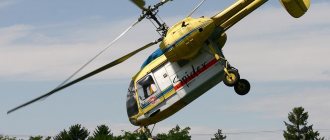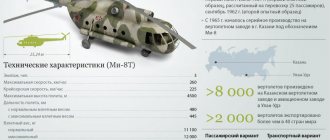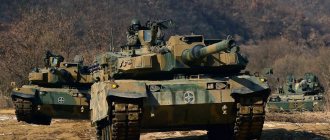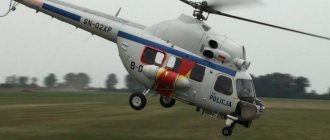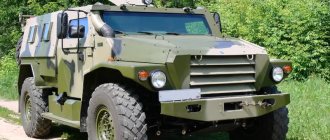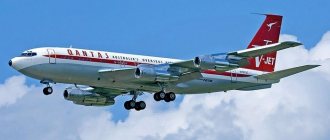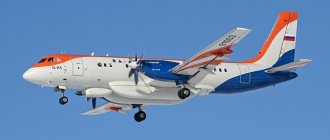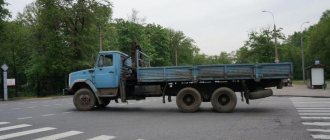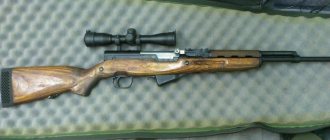The Russian-made Ka-50 attack helicopter is a combat vehicle designed to destroy enemy armored vehicles and enemy aircraft. The Ka-50 also has other names; during design it was designated “product 800”, and after entering mass production it was dubbed the “Black Shark”.
Due to the fact that this vehicle is single-seat, it copes well with traditional combat tactics and perfectly performs reconnaissance tasks. For reconnaissance, it was initially planned to use unmanned vehicles or the Ka-52 helicopter, but the Ka-50 helicopter can efficiently cope with such tasks independently.
When performing combat missions, the helicopter is first located at a base near the site of combat operations, where right in the cockpit the pilot can receive complete information about his location and the location of enemy forces. Weapons are aimed using modern equipment with an error of only a few meters. After delivering a precise strike on enemy forces, the helicopter leaves the area affected by air defense weapons.
The helicopter was designed and developed at the Kamov design bureau. The helicopter entered service in the Russian Federation in 1995, and serial production was discontinued in the winter of 2009. The refusal was made in favor of a newer and improved model of the Ka-52 two-seat attack helicopter.
History of the creation of the Ka-50 helicopter
The development of a new attack helicopter began in the winter of 1976 by decree of the Council of Ministers of the Soviet Union. The new device was supposed to replace the Mi-24 combat helicopter, which lacked combat power. The new project was also influenced by the appearance of an American analogue called AN-64. The appearance of the car was developed jointly by the Kamov and Mil bureaus. The Kamov Design Bureau specialized mainly in the production of marine helicopters; it was for this reason that the new machine was equipped with a double coaxial rotor, like marine models. It was the first land vehicle with this type of rotor. Mikheev was appointed chief designer, who from the very beginning abandoned standard similar helicopter models.
Due to the use of coaxial propellers, the helicopter received greater lift without losing power. This led to the fact that the helicopter acquired the ability to rise faster in the vertical plane and a greater maximum lift height. The blades of the new helicopter had a smaller diameter, which led to a higher rotation speed, which reduced flight resistance and made it possible to obtain high speed during horizontal flight. The overall weight of the vehicle was reduced due to the absence of a tail rotor. And at the same time, the helicopter has acquired greater survivability, since combat damage to the tail of the aircraft will not cause much damage and will not lead to a malfunction of the vehicle.
Another feature of this vehicle was the reduction in the number of crew to one pilot. The elimination of a co-pilot was made possible through the use of modern navigation and sighting equipment of domestic production. Using new technology, it was possible to automate a large number of devices and units. Using only one pilot resulted in cost and time savings in many positions. Firstly, significantly less armor can be used for one pilot, which will also lead to a reduction in the weight of the vehicle. Secondly, time and money were saved on pilot training in peacetime, since the number of personnel servicing the aircraft was reduced. And in combat times, single-seat helicopters will reduce the number of losses among pilots.
On the Ka-50 helicopter, for the first time, a new type of rescue system for the pilot was used, which did not exist before, namely, this device was equipped with an ejection seat.
[edit] Srachi
Srach
And here, dear Anonymous, we get to the most interesting part. Because arguments regarding the Ka-50 are an obligatory attribute of any decent aviation forum. Their main topics: transferring characteristics from the previous section to the minuses/pros and back, measuring pussy with the Mi-28, hundreds of HATE for the leadership of this country.
But the matter is not limited to the Internet. Fights also break out periodically between the manufacturers of the two aforementioned helicopters. Usually it happens like this: some highly specialized magazine/website interviews a “competent specialist.” This specialist, as a rule, immediately begins to tear off the covers and shout that the Ka-50 is garbage, and they chose it only because the Mi-28 looked too much like an Apache, but the Black Shark - yes, it will make anyone shit with bricks.
The Kamovites answer something like: “We don’t give a fuck, our helicopters are still better, and under our license, the Zvezda concern began producing plastic models of the Ka-58, which are only on drawings and will never go into production. And you are Milev’s beggars, and you are envious, HAHAHA.”
In general, the milefags throw shit at the kamophages, and the latter try to prove that they are all in white anyway.
Basically, the srach consists of the following points:
- — You can catch the overlap of the blades on your coaxials, which is not a good thing to do.
— It’s no easier than cutting off the tail boom with the main rotor of a classic, but your Mil makes flying coffins.
- “These coffins took part in almost all local conflicts, and your Shark is an unknown fucking piece of shit that doesn’t know how it will behave in battle.
- Ololo! That’s why Mi-24s in Afghanistan were shot down by the hundreds from Kalash rifles and light machine guns.
- — One pilot can’t do shit.
“Stormtroopers fly alone and don’t feel inferior.
- — Mil screwed up all the competitions in the 80s.
- Who fucked up, you fucked up, damn it! This is all Kamov's pear!
- — Colonel Rudykh says that the Ka-50 is cooler, and one pilot is a feature, not a bug! And he, by the way, flew on both helicopters.
— And do you trust the opinion of a person who compares a helicopter and an attack aircraft from the Second World War as an argument?
- — During tests to search for targets, the Mi-28 detected all the targets and was not detected, but the Ka-50 found only two and burned out on takeoff.
— Now there is a modification of the Ka-50Sh and it is also equipped with a thermal imager and night vision. Also, the Mi-28 has 2 pilots, which means it’s easier to burn down the enemy.
Design of the Ka-50
The helicopter is equipped with a twin-engine power plant that transmits power to a coaxial main rotor. The helicopter has straight, elongated wings with high-quality tail in all planes. In the manufacture of the machine body, a large number of polymer materials and aluminum alloys were used, which again led to a reduction in the weight of the helicopter. 30% of the helicopter's total mass is made of composite materials. All this has led to simplification of the manufacture of parts and reduction of their cost, and most importantly, they have a significantly longer service life.
The fuselage is divided into three compartments: front, rear and tail. The structure is strengthened using spars. In the bow of the helicopter there is a pilot's cabin, which is completely sealed and equipped with reinforced armor. It protects the pilot from enemy armor-piercing bullets. The total weight of the vehicle's armor is about 350 kilograms. Half of the cockpit glass is made of transparent armor.
In the middle part of the helicopter there are boxes with ammunition for guns and fuel tanks of the vehicle. Electronic computer equipment for controlling all helicopter systems is also located here. This compartment contains mounts for engines and gearboxes, as well as elements of the steering system. At the rear of the vehicle there are blocks in which radio equipment is installed.
The wings of the Ka-50 are quite long, have a span of 7.3 meters and are swept in shape; they are designed to unload the propellers at high speeds. The wings have four places for attaching weapons. The wings make it possible to mount weapons or additional tanks weighing 2 tons. In addition, winches are installed on the wings, which allow lifting loads weighing up to 500 kilograms.
The helicopter landing gear consists of three struts that are retracted during flight. The front support is equipped with a pair of wheels, with which you can effectively steer on the ground. The chassis is equipped with a vibration damping system, which can safely break when the machine is overloaded. In an emergency or when the landing gear is not opened, the helicopter can be landed on its belly, while the wings protect the machine from tipping over.
The efficient flight of the vehicle is ensured by two gas turbine engines, each producing 2.2 thousand horsepower. The engines of the power plant are located on the sides of the hull in nacelles. The advantage of the engines is that they are equipped with automatic oil systems that provide lubrication of all components and assemblies. The oil system prevents overheating and wear of moving engine parts. The power plant has a high degree of safety, since it can continue to operate even with a complete loss of oil for another thirty minutes. The engines are equipped with centrifugal dust collection systems. To reduce visibility in infrared light, the device is equipped with screen-exhaust systems.
The Ka-50's supporting system is represented by two coaxial propellers, which have three blades each. They are attached to the shaft using bushings and additional torsion bars. The main propeller is controlled by an automatic skew system. It should be noted that the upper main rotor rotates clockwise, and the lower rotor rotates counterclockwise. The propeller blades can withstand hits from projectiles up to 20 mm and still remain operational.
The Ka-50 helicopter is also equipped with a host of other systems that give the aircraft excellent flight and combat qualities.
Advantages and disadvantages
The Ka-50 was a truly “revolutionary” helicopter. To some extent, this let him down, because only the Ka-52 went into large production. Nevertheless, the Black Shark had a significant set of advantages:
- Outstanding maneuverability. The helicopter is capable of “sliding” sideways while simultaneously firing from on-board weapons, flying tail first at speeds of up to 90 km/h, and even performing a “dead loop” without any acceleration;
- The powerful and accurate gun is the best in its class;
- The on-board electronic complex allows the pilot to confidently control the flight and simultaneously fire at targets;
- The helicopter has small dimensions, is easy to transport and is not so easy to notice in the air;
- The cockpit and vital systems are reliably protected by armor;
- The helicopter is equipped with a rescue system that greatly increases the pilot's chances of survival.
The disadvantages of the Ka-50, oddly enough, are some of its advantages, namely: the use of a pine design and “single-seat”. Both have caused and continue to cause fierce controversy. In particular, there is a lot of talk about the danger of rotor blades overlapping. Such cases did occur, their causes have been eliminated, however, such developments cannot be completely ruled out.
The refusal of a second crew member, according to some military experts, was in itself a mistake, since the helicopter pilot has to perform too many functions that are different in nature. On the other hand, the weight of the vehicle is reduced, and it becomes possible to strengthen its armor or install additional equipment. This question has never received a final resolution.
The main external difference between the Ka-50Sh and the base model is the presence of a spherical GOES in the forward part of the fuselage
Modifications of the Ka-50:
| Ka-50 | the first modification of an attack helicopter. |
| Ka-50Sh | night attack helicopter. |
| Ka-50N | night attack helicopter. |
| Ka-50-2 Erdogan | two-seater modification according to NATO standards |
| Ka-52 Aligator | two-seat reconnaissance and attack helicopter |
The Black Shark helicopter, despite the fact that it was created more than 30 years ago, is still one of the best combat helicopters used by the Russian army. The main advantage of this combat helicopter is the ability to fly low above ground level - the combat vehicle is capable of flying steadily only 1.5-2 meters above the ground, and if any obstacle arises, the vehicle is able to quickly gain the required altitude.
The Black Shark helicopter began to operate only in 1995, since up to that point it had undergone all kinds of tests, which lasted almost 13 years. To date, only 15 combat vehicles of this type have been created, two of which crashed: one helicopter crashed during the first tests in the year of its creation, and the second crashed in 1998.
[edit] Links
- Another one.
- And further. According to the Mi-28 interspersed with sracha.
- But here everything is seriously described and with drawings.
- A page with a video where stern guys talk about military affairs in Chechnya and what a wonderful prodigy this Ka-pisyat is
| [ + ] Ka-50 is the key to victory! | |||||||||||||||||||||||
| |||||||||||||||||||||||
| [ + ] The Ka-50 is the pride of the aircraft industry. | |||||||||||||
| |||||||||||||
Helicopter K-50 “Black Shark”. Photo.
An interesting fact is that until 2007, not a single country used coaxial rotorcraft in its army, and Russia became a real leader in this regard . What does the coaxial arrangement of screws give? Here it makes sense to list several advantages:
- Performing aerobatic maneuvers, for example, the “Funnel” figure, the execution of which involves circling around the intended target with its constant capture by pointing the weapons;
- Fast climb;
- Large pitch angle.
There are a number of other advantages, primarily related to the maneuverability of the Black Shark combat helicopter, also known by the name Ka-50.
The black shark helicopter, a photo of which you can see in front of you, clearly demonstrates not only its fairly compact dimensions, but also its so-called secretive shape, because few people know that a helicopter is difficult to detect by radar even at high altitudes, however, provided that it will be used meter wavelength.
As for the characteristics, the Black Shark helicopter can boast of its low weight, quite decent flight speed, averaging 270 kilometers per hour, which is slightly lower than the American Apache, but on the other hand, the maximum lifting altitude of the helicopter is more than 6 kilometers, which is beyond the power of almost any helicopter. The mass of the helicopter is only 7700 kilograms, but on the other hand, if necessary, the helicopter can lift an additional 3 tons of various weapons.
It is also worth noting that there are a huge number of facts about the Black Shark helicopter, including those related to those that have never been demonstrated before. A typical example of this is testing a helicopter landing without a tail, which naturally can happen in combat. The helicopter, of course, will not be able to continue the battle, but it will make an emergency landing without any damage to the pilot or the ammunition on board. There is even a film about the helicopter “Black Shark” , which was released in 1993, that is, before the actual use of the combat vehicle in the Russian Air Force.
A film about a helicopter "Black Shark". Video.
The Black Shark helicopter is still in operation today, however, the production of combat vehicles has been temporarily suspended due to the high cost and inappropriateness of its use, however, we can confidently say that this means of military aviation is one of the best to this day in the whole world.
The first part of the Digital Combat Simulator series
The first part of the Digital Combat Simulator
. Unlike previous Eagle Dynamics simulators, in this project the bar for realism and depth of aircraft simulation was raised very high, which will allow virtual pilots to fully experience the work of army aviation pilots.
It is worth noting the depth and detail of the modeling of the flight dynamics of the coaxial helicopter, systems and weapons of the Ka-50. The level of artificial intelligence of ground combat equipment and aircraft has increased noticeably. The new mission editor, with the ability to program trigger events, will allow you to create more exciting and “live” missions. The new Campaign Builder has the ability to create non-linear campaigns based on the player's mission results.
Helicopter Ka-50 “Black Shark” characteristics
- Crew - 1 person.
- Maximum take-off weight - 10800 kg
- Normal take-off weight - 9800 kg
- Maximum mass of expendable combat load - 1811 kg
- Normal mass of expendable combat load - 610 kg
- Empty helicopter weight - 7692 kg
- Maximum flight speed - 300 km/h
- Cruising flight speed - 270 km/h
- Static ceiling - 4000 m
- Dynamic ceiling - 5500 m
- Flight range with normal take-off weight - 460 m
- Ferry range - 1160 km
- Length with rotating screws - 16 m
- Height - 4.93 m
- Main rotor diameter - 14.5 m
Helicopter K-50 “Black Shark”. Gallery.
View other helicopters
